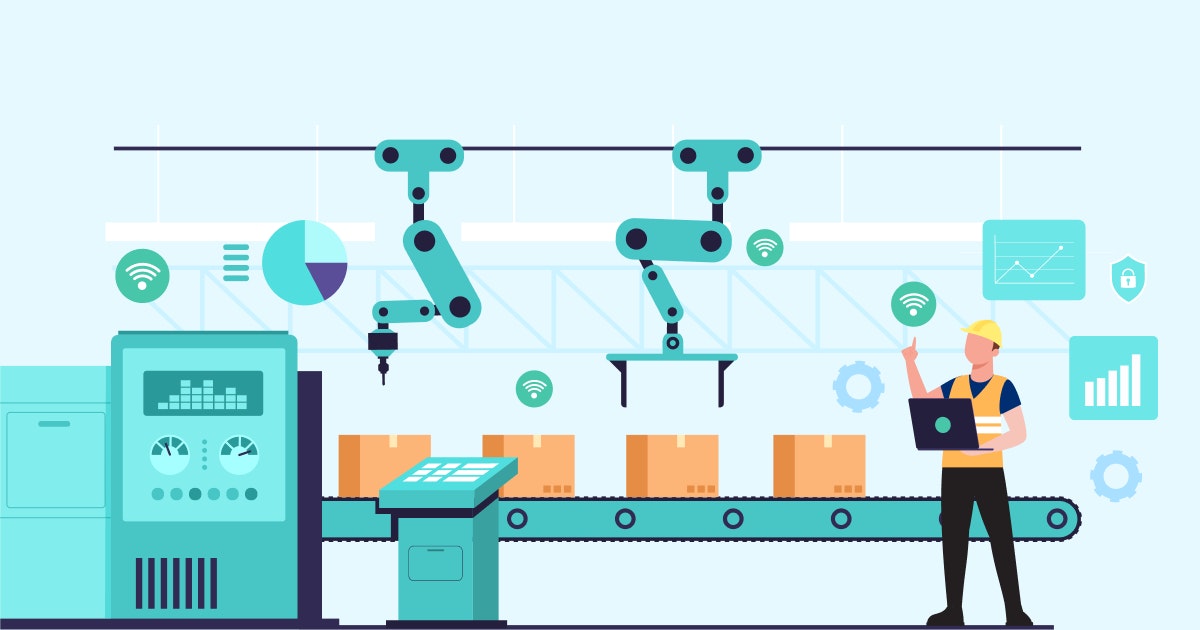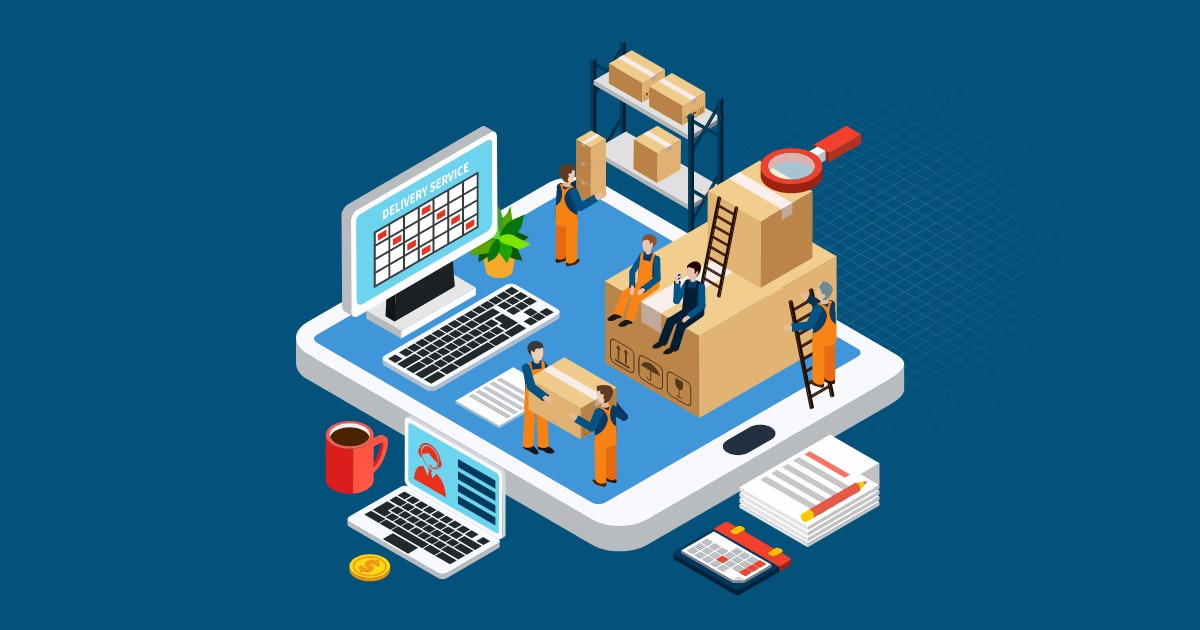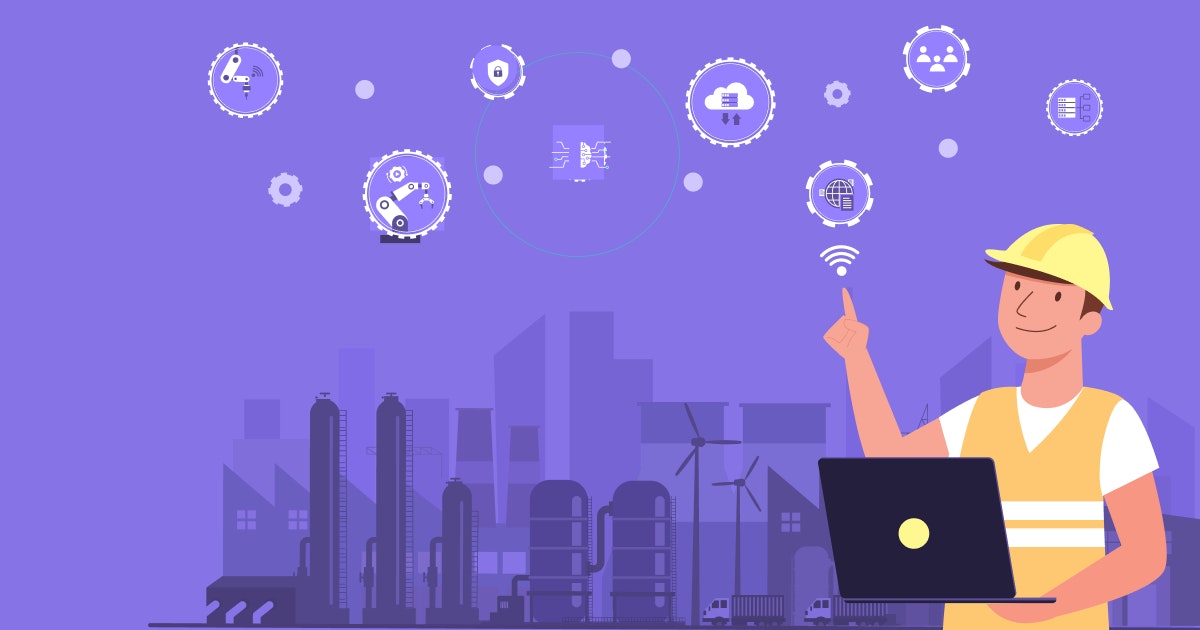Table of Content
We live in a world where new technologies are being constantly innovated. The Internet of Things (IoT) has significantly transformed supply chain management across industries by allowing machines to connect and interact with products and end-users.
IoT has undoubtedly helped usher in the Fourth Industrial Revolution. As per Bain's research, B2B apps of IoT will generate $300 billion in revenues by 2022.
A similar McKinsey analysis predicts IoT's contributions to SCM, inventory management, and logistics can surpass $560 billion by 2025. This is not surprising as IoT is an ever-expanding network of devices, including headphones, smartphones, wearables, and lamps.
With technologies such as WiFi, beacons, BLE, and LWAN making connectivity energy and cost-efficient, warehouses are becoming 'smarter' by integrating IoT with their infrastructure.
IoT in smart warehouse management
Warehouse errors can cause a massive hole in the pocket. In a traditional setup, a warehouse manager's most significant challenge comes from a lack of data available to make an informed decision. Inaccurate operations require more labor to fix, which further adds to the overall expenses.
That is the reason why businesses are now installing IoT sensors in their warehouses to track the movement of products and the use of materials and other assets in manufacturing units. They also deploy sensors on shelves to transmit real-time inventory information to their management system, which ultimately helps curb expensive and time-wasting mistakes.
A robust IoT network will enable easier monitoring and control of the entire warehouse, even remotely. It will save costs and time on tasks such as locating products across a warehouse, keeping stock of the inventory, and monitoring stock movements.
Leveraging wireless internet connectivity, sensor networks, real-time data, and IoT platforms will drive greater efficiency in warehouse management.
Upgrade Your Warehouse Systems with Smart IoT Technology!
Explore Solutions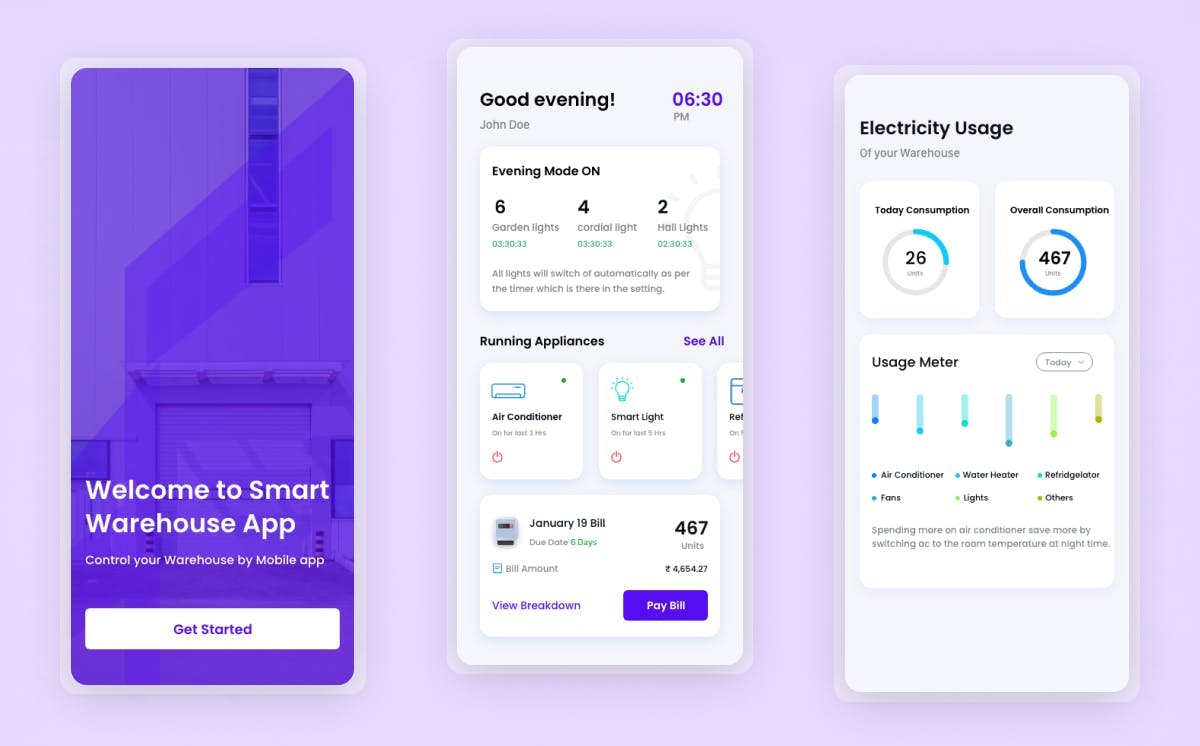
7 practical applications of IoT in smart warehouse management
One thing is clear — the traditional supply chain is not designed to handle an enormous volume of small orders for immediate delivery. Whether a particular item is in stock online or it is available in a nearby store, not having real-time information about the products hurts a company's reputation and hampers customer loyalty.
Manufacturers, warehouses, retailers, and logistics providers struggle to adjust to meet ever-changing consumer demands through their supply chains. Here is a list of seven IoT development services that have proven their mettle in warehouse management.
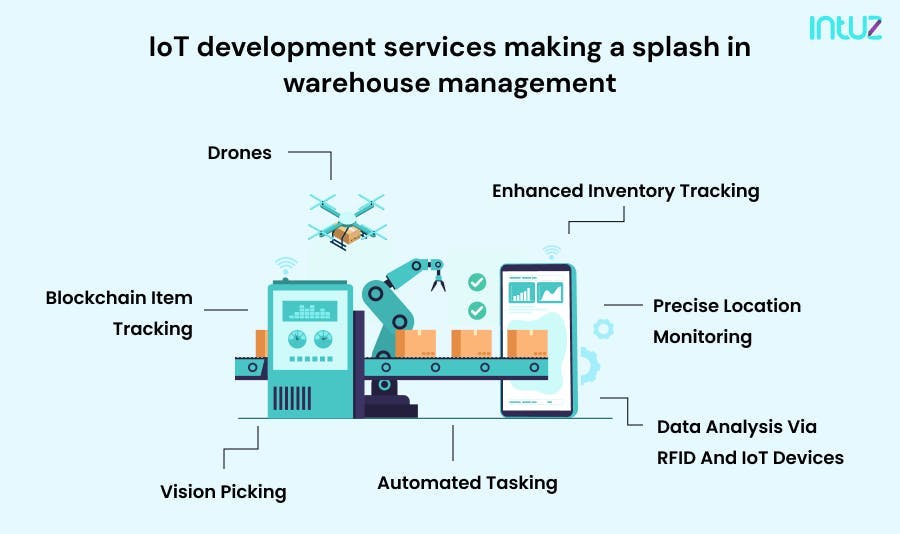
1. Drones
Managing inventory in a warehouse is challenging without the right tools. In most cases, employees would still need access to a ladder for high shelves, limiting productivity while also increasing risks of workplace injuries.
Drones offer an affordable and efficient way to help managers keep track of inventory in real time. IoT devices will be able to scan any item without interference from humans, thus reducing the risk of accidents or errors.
In addition to locating items across the floor, moving them will also become more manageable. Drones and humans can take shifts to manage the inventory, thereby reducing unnecessary workload while delivering maximum security.
Humans can handle their part of the work during the day, while remote-controlled laser vision-enabled drones can manage the rest of it even at night and improve efficiency.
2. Blockchain item tracking
Blockchain is a game-changer for the warehousing industry. The technology provides warehouse and inventory managers with instant visibility into how well their products are selling and tracking their physical location in real time.
It saves costs for both the workforce and non-fiscal resources. Blockchain helps store managers detect theft quickly. They can pinpoint where exactly something went missing while simultaneously keeping tabs on sales across stores.
With Blockchain, warehouse managers will be able to forecast demand based on the data logs. The relatively new technology also helps meet the regulatory requirements of the supply chains by complying with chain-of-custody guidelines conveniently.
3. Vision picking
Smart glasses enable workers to handle work hands-free and provide the perfect solution for effortlessly picking items for transporting them to different zones in a warehouse. With connected wearables with intuitive interfaces, workers can speed up their work.
When they are new to the warehouse, the workers need to learn how to operate the devices. It takes less time than memorizing the area of each type of goods and locating them manually if they have smart glasses with them.
In addition, automatically tracking products throughout the floor saves costs while increasing productivity dramatically. The Vision Picking Systems also automatically documents product lots, eliminating the need for paperwork.
It also reduces errors in packing orders as each item is automatically scanned by the smart wearables while double-checking the details of contents with the order.
4. Automated tasking
The tasks of picking and packing are monotonous and tiresome for humans. An IoT development company can help automate these assignments through robotic assistants. It helps free up time for workers and managers to focus on more complex activities that demand higher human intervention.
Deploying collaborative bots, Mobile Rack GTP AMR robots, and Unit Load Transport AMRs helps speed up warehouse functions as they perform more work in less time. The use of robots and automation reduces losses associated with human error.
IoT technology also helps ensure quality by decreasing inaccurate orders or damaged products from being shipped out of the warehouse.
Sensors monitor everything from temperature levels (to protect against spoilage), weight distribution, and storage conditions across different areas within the facility. It helps in eliminating spoilage due to improper storage and saves costs.
5. Data analysis via RFID and IoT devices
RFID tags simplify keeping track of your physical inventory. With the help of these, warehouses can save time in locating products across the floor. Spoilage and wastage of products can be easily monitored, which leads to more minor losses in terms of money for the business.
In addition, you can keep track of when each product expires to make sure to move the right items at the right time. IoT technology also helps you monitor inventory levels so that there is never too much or too little left in stock at one time.
RFIDs give protection against theft as well as you can keep track of products that have gone missing. Real-time monitoring keeps crime at an all-time low. Plus, managers can predict demand by analyzing data to see which products sell more and faster by when.
6. Precise location monitoring
The use of IoT devices in inventory management also helps track the product from plant to delivery. It is helpful for route planning to optimize the delivery process and save costs.
For instance, you can use sensors to ensure more efficient storage during transit as well as identify delays along the supply chain, enabling you to predict delivery timelines accurately.
Real-time tracking helps monitor the items until delivery and assists emergency planning in case of traffic congestion or changing weather conditions. IoT helps speed up your delivery processes while maintaining transparency at all levels of the supply chain.
7. Enhanced inventory tracking
Deploying IoT devices and networks in warehouses can help real-time inventory tracking. It contributes to improving stock management through data-backed decision-making.
IoT sensors can be installed in various locations within the warehouse, such as on shelves, racks, or pallets. These sensors can detect when an item is removed or added to a location, and they can also track the movement of items around the warehouse.
This data is then used to create a map of the inventory that shows where each item is located at any given time. It also helps predict demand and automate ordering for refills. Reduced human intervention helps in improving overall efficiency.
IoT devices for warehouse management
To implement these applications, warehouses rely on a variety of IoT devices:
RFID Tags and Readers: These allow for contactless identification and tracking of inventory items.
Smart Sensors: Devices that monitor environmental conditions, occupancy, and equipment status.
Bluetooth Beacons: Low-energy devices used for indoor positioning and asset tracking.
Smart Cameras: AI-powered cameras for visual inspection, security, and activity monitoring.
Voice-picking Headsets: Wearable devices that provide audio instructions to workers for hands-free operations.
IoT Gateways: Devices that connect various sensors and equipment to the central management system.
Smart Shelves: Weight-sensing shelves that automatically detect inventory levels.
Robotic Arms: Programmable arms for automated picking and packing tasks.
Drones: Used for inventory counting on high shelves or hard-to-reach areas.
IoT-enabled Mobile Devices: Tablets and smartphones that allow workers to access real-time data and control systems on the go.
By leveraging these IoT devices and applications, warehouses can significantly improve their efficiency, accuracy, and responsiveness. The result is a smarter, more agile supply chain that can meet the demands of today's fast-paced business environment.
Benefits of IoT for warehouse managers
There is no doubt that technology quickly fuels changes across supply chain networks. Any inventory manager's biggest concern is not having enough data to make decisions.
Sure, updating legacy systems with IoT devices can help boost overall efficiency by enabling traceability, better tracking, compliance, and quality management.
The need for this evolution is necessary as warehouses today are seen as critical business hubs. They cannot afford to perform lazily if they want their parent companies to thrive. That is how IoT technology has found its purpose in this sector.
Today, businesses must consider the investment costs, security, and expandability of integrating IoT devices within their current inventory management workflows. Here are the benefits they can hope to enjoy with IoT:
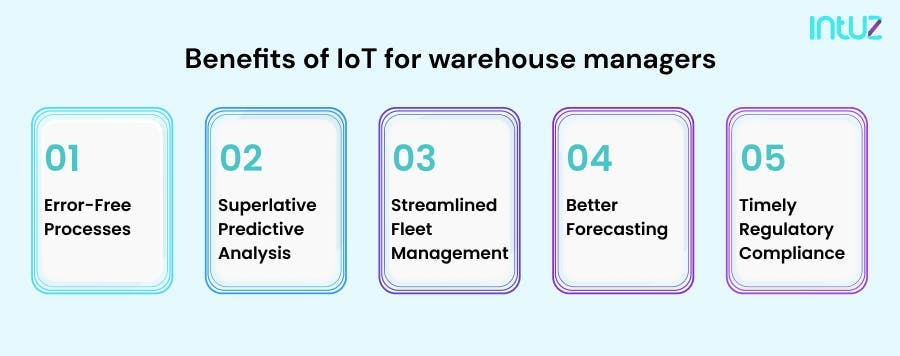
1. Error-free processes
IoT helps manage warehouse operations such as receiving, inventory management, order fulfillment, shipping, and accounting. The main benefit of deploying IoT is that it makes all warehousing processes error-free.
Data gathered from various end-points is automatically entered into the warehouse management system, and it regularly updates as per the fluctuations in inventory levels. Manual data collection and entry are time-consuming and often lead to errors.
Another benefit of deploying IoT in warehouse management is that the technology enables you to track inventory levels. You can ensure that there is always enough stock available to meet demand.
When the stock falls below a certain level, the system will automatically generate a purchase order to replenish it, reducing instances of stock shortage. This will also lead to increased customer loyalty in the long run.
2. Superlative predictive analysis
The data collected by the IoT devices help optimize the supply chain through effective material handling and smart warehouse management. It gives you enough information to forecast demand and order inventory accordingly.
You can also use the data to see which items in stock must be moved out first. Predictive analysis helps immensely in determining the overall productivity of the warehouse through actionable insights and generates higher profits for organizations.
Automated data collection and real-time analysis reduce the effort of managers in decision-making. With key numbers in front of them, they take less time to put plans in action and execute them to perfection.
3. Streamlined fleet management
IoT technology enables the monitoring of the fleet remotely. Warehouse managers can keep track of their vehicles, including their availability for scheduled deliveries.
It allows managers to monitor the condition of the vehicles and detect any upcoming issues cutting down emergency repair costs.
Real-time tire pressure management systems, route optimization systems, and driver monitoring systems ensure the stock reaches its destination on time and in proper condition.
The costs of stock transportation can also be controlled by reducing unnecessary idling, avoiding uneven accelerating and decelerating patterns, controlling sudden braking, and maintaining average speed to achieve fuel efficiency.
4. Better forecasting
IoT devices collect a lot of data that can be used to forecast demand. The data can help warehouse managers better plan their inventory and forecast demand for specific items. Studying the data helps managers detect patterns in customer behavior that can be used to improve forecasting.
By using IoT in conjunction with other forecasting methods, warehouse managers can get a more accurate picture of future demand and make better decisions about inventory management. They can even forecast the time to reorder stock by identifying trends in customer demand and acting on them immediately.
5. Timely regulatory compliance
IoT devices have the potential to streamline traceability and inventory management for compliance in highly regulated manufacturing industries.
Implementing blockchain technology helps ensure regulatory compliance throughout the supply chain by giving accurate information about shipped products. It also helps maintain security for workers on the floor in line with industrial security standards.
Let's Streamline Your Warehouse Processes with Advanced IoT!
Contact UsWrapping it up
Warehouses have been transforming into critical business hubs that increase efficiency and speed across all supply chain networks in the past few years.
IoT devices being used in these facilities will offer more outstanding tracking, traceability, quality management, and compliance capabilities. Stocktaking, inventory rotations, and quality checks can occur seamlessly without disrupting day-to-day operations.
Deploying IoT in warehouse management will help business owners automate repetitive tasks to speed up processes, efficiently cater to customers, implement better security measures to reduce the risk of accidents, and save costs too.
By using IoT technology, the transparency and efficiency of business operations can be increased to deliver a better customer experience. Is that not the end goal of every company?
Book a Free 45-minute Consultation with Our IoT Experts Today! Get a customized roadmap and strategies to leverage IoT for smart warehousing management!
